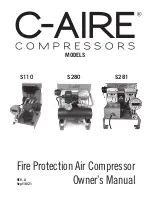
9
© 2016 Emerson Climate Technologies, Inc.
AE4-1402 R4
mounting feet so mounting grommets with a relief are
not required.
Table 1
lists the recommended mounting
parts. It is extremely important to use the correct
durometer grommet and to have consistent durometer
quality. Wrong or inconsistent durometer of the
mounting grommets can result in sound and vibration
complaints. For additional information on grommet
durometer please consult with Application Engineering.
Discharge Mufflers
For a variable speed compressor, discharge pulse
will generally decrease as speed increases or if
compression ratio decreases. As speed decreases or
if compression ratio increases the discharge pulse will
increase. Fixed capacity or two-step capacity units have
typically had discharge gas pulsation mufflers only in
heat pump applications. A variable capacity heat pump
and/or air conditioner may both require a discharge
gas pulsation muffler. Discharge pulse amplitude and
frequency and their effects on the piping system must be
taken into account. If testing determines that a muffler
is needed to attenuate discharge pulse, a hollow shell
muffler such as the Emerson Flow Controls APD164S
must be used.
The mufflers should be located a minimum of six
inches (15 cm) to a maximum of 18 inches (46cm)
from the compressor for most effective operation. The
farther the muffler is placed from the compressor within
these ranges the more effective it may be. If adequate
attenuation is not achieved, use a muffler with a larger
cross-sectional area to inlet-area ratio.
Airborne Sound Control
In addition to structure and gas borne sound transmission,
special consideration needs to be given to compressor
airborne sound. A-weighted, steady-state sound data is
available from Application Engineering. Sound data is
also available at the nominal cooling condition of 50°F
(10°C) evaporating and 115°F (46°C) condensing at
5400 RPM. If airborne sound attenuation is required for
the application, Fabricating Services (www.fabsrv.com)
is one manufacturer of custom sound solutions
Expansion Devices
The expansion device is a crucial component of
the variable capacity system. Fixed-orifice devices,
which are chosen or optimized at one particular
operating condition, will not have the ability to control
the refrigerant flow across a wide range of operating
pressures and flow rates required by the variable
capacity system.
To better control superheat, an electronic expansion
valve (EXV) is recommended. Electronic expansion
valves have the ability to more precisely control
superheat at lower settings over a wider operating range
than a TXV. They also have the capability to be driven
completely closed during the off-cycle, minimizing off-
cycle migration.
Regardless of which expansion device is used, the
manufacturer's recommendations on the application of
the valve should be followed in all cases.
Reversing Valves
A variable speed scroll has a real advantage during the
defrost cycle. By taking advantage of the higher speeds
and flow rates, defrost time will typically be shorter than
a system with a fixed or two-step capacity compressor.
This reduces the time heat is required during the defrost
cycle.
CAUTION Reversing valve sizing must be within
the guidelines of the valve manufacturer. Required
pressure drop to ensure valve shifting must be
measured throughout the operating range of the
unit and compared to the valve manufacturer’s
data. Conditions that result in low flow rates and
low pressure drop across the valve can result in
a valve not shifting. This can result in a condition
where the compressor appears to be not pumping
(i.e. balanced pressure). It can also result in
elevated compressor sound levels.
During a defrost
cycle, when the reversing valve abruptly changes the
refrigerant flow direction, the suction and discharge
pressures will go outside of the operating envelope. The
condition will usually cross the diagonal line representing
the lower right hand corner of the envelope. The sound
that the compressor makes during this transition period
is normal, and the duration of the sound will depend on
the coil volume, outdoor ambient, and system charge.
The reversing valve solenoid should be wired so
that the valve does not reverse when the system is
shut off by the operating thermostat in the heating or
cooling mode. If the valve is allowed to reverse at the
system shutoff, suction and discharge pressures are
reversed to the compressor. This will result in pressures
equalizing through the compressor which can cause
the compressor to slowly rotate backwards until the
pressures equalize. This condition does not affect the
compressor durability but can cause unexpected sound









































